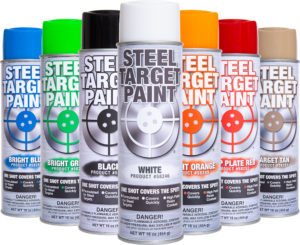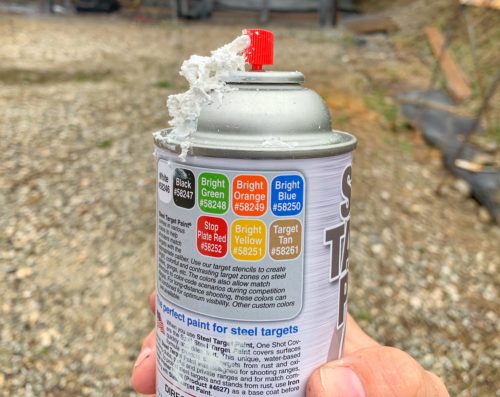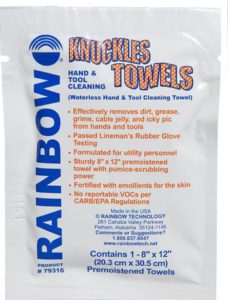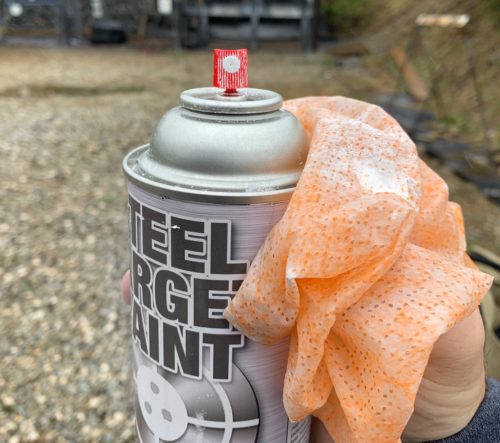 Steel Target Paint is a huge supporter of the Practical Shooting Sports, and their paint products are widely used not only in Steel Challenge matches at every level, but also in USPSA and other disciplines of Practical Shooting. As well it should be – Steel Target Paint has been formulated specifically for the Shooting Sports and is superior in every way to all-purpose spray paint found in hardware stores. But because Steel Target Paint is different, it should be used differently than how many people are accustomed to using conventional spray paint. Used correctly, a single can of Steel Target Paint can last an entire day on a stage of a Level II or higher match (assuming one session per day) – that’s probably three times longer than most other paints I’ve used will make it. So what are the best practices when using Steel Target Paint?
Steel Target Paint is a huge supporter of the Practical Shooting Sports, and their paint products are widely used not only in Steel Challenge matches at every level, but also in USPSA and other disciplines of Practical Shooting. As well it should be – Steel Target Paint has been formulated specifically for the Shooting Sports and is superior in every way to all-purpose spray paint found in hardware stores. But because Steel Target Paint is different, it should be used differently than how many people are accustomed to using conventional spray paint. Used correctly, a single can of Steel Target Paint can last an entire day on a stage of a Level II or higher match (assuming one session per day) – that’s probably three times longer than most other paints I’ve used will make it. So what are the best practices when using Steel Target Paint?
SHAKE WELL. THEN SHAKE AGAIN
This is probably the biggest difference when using Steel Target Paint vs. conventional spray paint. You’re probably used to grabbing a can of paint, giving a couple of shakes, then applying. But the directions on Steel Target Paint actually state to shake for one minute after you hear the ball rattle. Steel Target Paint has a great deal of resin in its formulation, which if not shaken well to evenly distribute within the paint can to “clump.” Here’s what happens to the can of Steel Target Paint that hasn’t been properly shaken before use:
So not shaking the product adequately has several negative consequences. The most direct consequence is that paint which does come of out the can does not perform as it was designed. Even if you manage to use the entire can of paint, much will be wasted. But more often than not, what I see happen in matches is that when someone comes across a can of paint that looks like the one above, they throw it away! I’ve seen entire cans of paint thrown away at matches due to the clumping which can happen as a direct result of not properly shaking a can before using it. The other problem that happens is that when people see cans of paint that look like the one above, they just won’t paint targets for fear of getting paint on their hands and clothes – which really slows down a match. Again, shaking a can of Steel Target Paint adequately before use is critical. Pro Tip: Keep some Knuckles Individual Hand Towels in your range bag.
Match Directors should also consider making sure there are some at every stage in their match. It takes about 30 seconds of wipe down with a Knuckles towel to clean off a can of Steel Target Paint that has clumped paint on it.
Also note that the red spray button easily pops off for cleaning. If paint has clogged it making the spray button inoperable, you can always swap it with one from an empty can. Generally speaking, if you’re throwing a can of Steel Target Paint away that has paint in the can, you’re doing it wrong.
A LITTLE GOES A LONG WAY
Most conventional paints are very thin and “watered down” in consistency, requiring a “buck shot” approach when spraying a target. However, when using Steel Target Paint, you don’t need layers of paint to cover the bullet impact spot on a steel target. Instead, hold the paint can 8-10 inches off the target surface and give one quick shot to cover only the bullet impact mark. Ideally, a target in Steel Challenge will need just five quick shots of paint. If the whole target needs to be painted, then make very quick transitions to keep from building up too much paint. If you see it bubble up you are too close or not moving fast enough. Done correctly, painting targets is done much more quickly using Steel Target Paint (reducing stage and overall match time) and requires very little paint.
When target painting is completed, invert the paint can and give a quick spray to clear out the spray button and valve – this will mitigate paint drying in the valve/spray button.
In summary, shake very well, spray only bullet impacts from 8-10 inches away, and clean the can if the squad that came before you didn’t read this article.
Steel Target Paint also has recorded a short video on how best to use their product which I highly recommend taking the time to watch:





0 Comments